Literary rating: ★★★★½
Kick-butt quotient: ☆☆☆
The six stories in this collection of short fiction featuring iconic heroine Modesty Blaise were all originally published in the Australian publication Pix in Jan.-Feb. 1970. O’Donnell intended them to be published in book form with illustrations by Jim Holdaway, then the artist for the Modesty Blaise comic strip; but Holdaway died that year, and the book-form collection wasn’t published for another two years. (See https://en.wikipedia.org/wiki/Pieces_of_Modesty .) In the interval, however, at least one of the stories, “A Better Day to Die,” was reprinted in an American magazine (I don’t recall which one), where I read it –I think in the spring of 1970, while I was still in high school. It was my first introduction to the character, and one of very few exposures I’d had in fiction to a kick-butt heroine (they were much less numerous in my youth than they’ve since become). My teenage self was pretty awe-struck by Modesty in action; so that gave me an abiding interest in her fictional exploits, although this is still only the second book by O’Donnell that I’ve read.
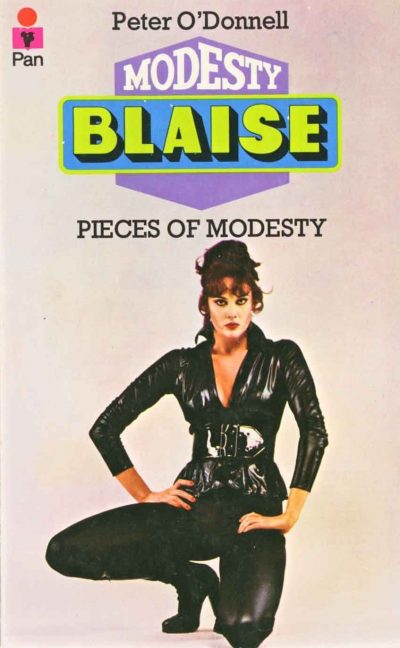 While this is the sixth installment of the series, because the stories are strictly episodic and not connected to each other, and are set at various times in the 60s, they don’t really have to be read after the first five novels to be understood and appreciated. (It would probably be best to read the first novel first, just to provide a foundation.) In a couple of stories, references are made to events, and characters reappear, which are probably drawn from the novels; but any information about past events that we need to know is supplied. Five of them are written in third person; “I Had a Date with Lady Janet” is unique in that Willie narrates it in first person, which helps to develop his character more deeply. The settings are mostly British or continental European, with one tale taking place in South America. All six adventures involve Modesty in a wide variety of situations, which illustrate various aspects of her personality and abilities; that may explain the collection’s odd title. (Don’t worry –Modesty is not dismembered!)
While this is the sixth installment of the series, because the stories are strictly episodic and not connected to each other, and are set at various times in the 60s, they don’t really have to be read after the first five novels to be understood and appreciated. (It would probably be best to read the first novel first, just to provide a foundation.) In a couple of stories, references are made to events, and characters reappear, which are probably drawn from the novels; but any information about past events that we need to know is supplied. Five of them are written in third person; “I Had a Date with Lady Janet” is unique in that Willie narrates it in first person, which helps to develop his character more deeply. The settings are mostly British or continental European, with one tale taking place in South America. All six adventures involve Modesty in a wide variety of situations, which illustrate various aspects of her personality and abilities; that may explain the collection’s odd title. (Don’t worry –Modesty is not dismembered!)
O’Donnell writes with a very readable, professional style, and creates captivating story-lines centered around well-developed characters. His plots aren’t overly convoluted, and their various elements dovetail nicely; that doesn’t keep some of the stories from having surprise twists, which grow naturally from the soil of the tale itself, as legitimate surprises should. (I did guess the general outline of one, before the author revealed it.) This is, of course, action-adventure pulp fiction; unusual, extreme and sometimes life-threatening situations are the norm, and our main characters are larger than life. That doesn’t mean the writing lacks literary quality, nor that it’s without realism, psychological and otherwise. Neither of those are in fact lacking; and neither is moral vision, and the ability to evoke serious thought about ethical questions. The author just evokes the kind of thought about them that today’s literary-critical clerisy doesn’t welcome, because he thinks that right and wrong are real categories, and that virtues such as courage, loyalty and justice actually ARE virtues.
In commenting on individual stories, I want to avoid spoilers. I’ll say simply that “A Better Day to Die” presents a serious, balanced and fair debate between absolute pacifism and the position that violent resistance to murderous and other harmful aggression is a legitimate last resort to protect the inoffensive, including oneself. (Modesty maintains the latter, and O”Donnell clearly agrees with her, as I do –but she respects the pacifist position.) “The Giggle Wrecker,” set mainly in East Berlin in the days of the Cold War, brings back the memory of that era vividly, and to my mind refutes the claim of some that there was an absolute moral equivalency between the West and Soviet totalitarianism. Willie’s narrative and “A Perfect Night to Break Your Neck” are noteworthy for their positive portrayal of physically handicapped characters (both of whom not only pull their weight, but enjoy serious romantic relationships with partners who appreciate them as persons).
 “Salamander Four” is the only selection here that indicates Modesty’s openness, on occasion, to uncommitted sex (although there’s no explicit sexual content there, or in any of the stories), but the psychology of it is understandable and she comes across to me as misguided rather than callous and selfish –it’s clear that her intention isn’t knowingly to be hurtful or exploitative. Finally, “The Soo Girl Charity” is the most disturbing of the stories, in that (though without being graphic) it provides a look into the dark reality of the exploitation of women by sexual sadists, and into the even darker reality of what pounded-in cultural brainwashing of females to accept patriarchy and male domination actually does to their psyches. (I didn’t feel that the victim here being Asian indicates racism or cultural stereotyping; I think that simply reflects a reality that, at least in the 60s, traditional rural Asian cultures still tended to promote that kind of brainwashing to a greater degree than Occidental ones –even though the sexism of our culture is bad enough.)
“Salamander Four” is the only selection here that indicates Modesty’s openness, on occasion, to uncommitted sex (although there’s no explicit sexual content there, or in any of the stories), but the psychology of it is understandable and she comes across to me as misguided rather than callous and selfish –it’s clear that her intention isn’t knowingly to be hurtful or exploitative. Finally, “The Soo Girl Charity” is the most disturbing of the stories, in that (though without being graphic) it provides a look into the dark reality of the exploitation of women by sexual sadists, and into the even darker reality of what pounded-in cultural brainwashing of females to accept patriarchy and male domination actually does to their psyches. (I didn’t feel that the victim here being Asian indicates racism or cultural stereotyping; I think that simply reflects a reality that, at least in the 60s, traditional rural Asian cultures still tended to promote that kind of brainwashing to a greater degree than Occidental ones –even though the sexism of our culture is bad enough.)
One quibble I had with the latter story is that I thought the premise had Modesty and Willie acting (at least, for their current post-Network situation) out of character in a couple of respects. A more important issue was with a comment about a brutal gang rape of a teen girl that occurs in one of the stories. That the incident could realistically be expected to happen, given the mentality of thugs put in a position to dominate unarmed females, I don’t deny (sadly, it would be more unrealistic if it didn’t); O’Donnell doesn’t treat it graphically and clearly disapproves of it. But afterwards he has Modesty thinking, at one point, “Just as well it had been Rosa. She was a sturdy peasant type with nerves like sisal. In a little while she might even begin to relish the cachet of having been raped by guerillas.” To be sure, the author doesn’t suggest that she relished the rape itself. But in the first place, I don’t think being raped carries any cachet, in a culture that sees virginity as a valuable commodity and sees rape victims as “damaged goods.” In the second place, I can’t imagine that this would be a reaction Rosa would ever have, nor that the idea would be one that Modesty (who was a rape victim herself in the past) would ever think. It comes across as the kind of insensitive, emotionally tone-deaf perception a male author might have who doesn’t have any real ability to imagine the actual psychology of a rape victim.
Overall, though, these caveats didn’t keep me from really liking the collection as a whole. Modesty is one of my favorite action heroines, and one whom I see as, on the whole, a pretty good role model –she has her faults, which are recognizable; but if both male and female readers pick up on emulating her virtues, they’d find a great many to aspire to. I’m glad to have spent this interlude in her fictional world, and still hope to read more of the Modesty canon eventually.
Author: Peter O”Donnell
Publisher: Souvenir Press, available through Amazon, currently only as a printed book.
A version of this review previously appeared on Goodreads.





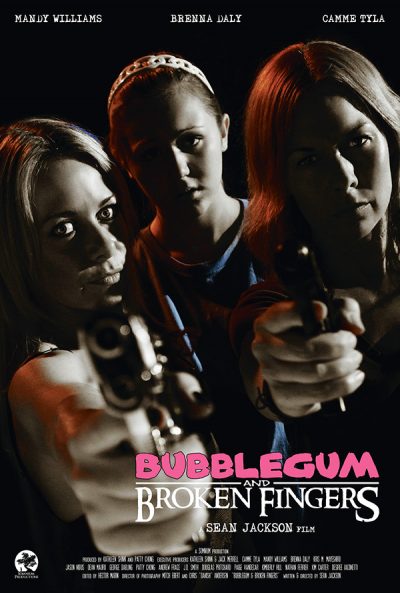 Outside of Kill Bill, I’ve never been a fan of Quentin Tarantino. But this film did give me some appreciation for him. Because it’s only when you see Tarantino done badly, that you realize the aspects he does well. It undeniably takes some skills to keep a story-line involving multiple sets of characters in the air, especially when centered on a Macguffin like a suitcase whose contents are never revealed. Jackson tries to do exactly the same thing here, and the result is, frankly, a mess, where you’re left caring little or nothing about any of the participants.
Outside of Kill Bill, I’ve never been a fan of Quentin Tarantino. But this film did give me some appreciation for him. Because it’s only when you see Tarantino done badly, that you realize the aspects he does well. It undeniably takes some skills to keep a story-line involving multiple sets of characters in the air, especially when centered on a Macguffin like a suitcase whose contents are never revealed. Jackson tries to do exactly the same thing here, and the result is, frankly, a mess, where you’re left caring little or nothing about any of the participants.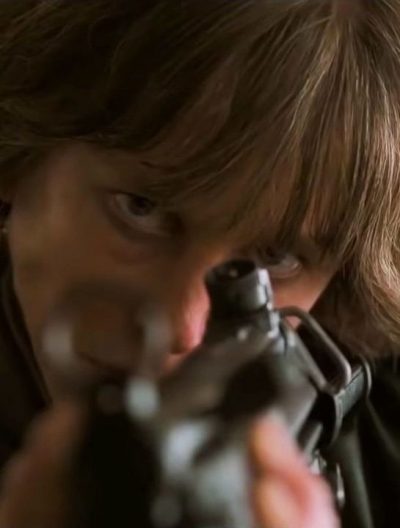 A fine, almost unrecognizable performance by Kidman succeeds in maintaining interest, despite a script which appears to regard time less like an arrow, and more like a big ball of wibbly-wobbly, timey-wimey stuff. Deeply troubled cop Erin Bell (Kidman) wakes up in her car, apparently badly hungover, looking like ten pounds of crap in a five-pound bag. Not far away, her colleagues are poring over a newly-discovered murder scene: a body with a dye-stained hundred-dollar bill on the corpse. And that’s about the last time when I was quite certain of the timeline.
A fine, almost unrecognizable performance by Kidman succeeds in maintaining interest, despite a script which appears to regard time less like an arrow, and more like a big ball of wibbly-wobbly, timey-wimey stuff. Deeply troubled cop Erin Bell (Kidman) wakes up in her car, apparently badly hungover, looking like ten pounds of crap in a five-pound bag. Not far away, her colleagues are poring over a newly-discovered murder scene: a body with a dye-stained hundred-dollar bill on the corpse. And that’s about the last time when I was quite certain of the timeline.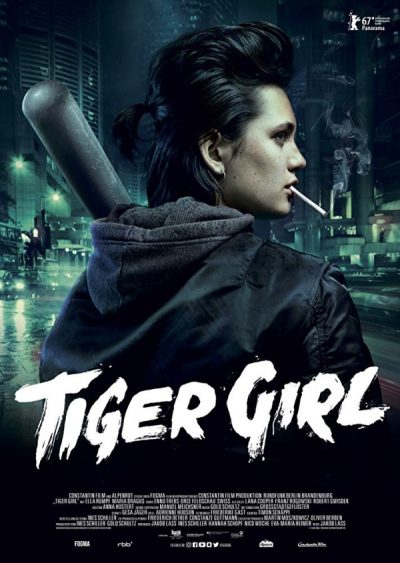 Maggie (Dragus) just failed the police entry exam in humiliating fashion, and is now taking a course to become a security officer, despite her meek nature. She encounters Tiger (Rumpf), a street punk girl who is everything Maggie is not: brash, confident and perfectly willing to go toe-to-toe with anyone she feels deserves it. The pair strike up an unlikely friendship, with a purloined uniform allowing Tiger to join Maggie in her security work, and in turn engage her increasing fondness for mayhem and violence. Meanwhile, Tiger’s example helps bring Maggie – or ‘Vanilla’, as Tiger calls her in half-mocking endearment – out of her shell. Though Tiger’s drug-dealing friends are less than impressed to find her palling around with a wannabe cop. And as Maggie begins to adopt a more… physical approach to confrontation, it becomes clear that Tiger’s restraint is something Maggie does not possess.
Maggie (Dragus) just failed the police entry exam in humiliating fashion, and is now taking a course to become a security officer, despite her meek nature. She encounters Tiger (Rumpf), a street punk girl who is everything Maggie is not: brash, confident and perfectly willing to go toe-to-toe with anyone she feels deserves it. The pair strike up an unlikely friendship, with a purloined uniform allowing Tiger to join Maggie in her security work, and in turn engage her increasing fondness for mayhem and violence. Meanwhile, Tiger’s example helps bring Maggie – or ‘Vanilla’, as Tiger calls her in half-mocking endearment – out of her shell. Though Tiger’s drug-dealing friends are less than impressed to find her palling around with a wannabe cop. And as Maggie begins to adopt a more… physical approach to confrontation, it becomes clear that Tiger’s restraint is something Maggie does not possess. I usually try to be tolerant when it comes to low-budget cinema and the resulting flaws. There are some things which you just cannot expect when a film is financed on the maker’s credit-card, and I’m willing to overlook rough edges if a movie can hold my interest in other ways. However, there are times when the end product is almost irredeemably bad, with few, if any, merits. This would be one such case. Your script is the main area which should be an area of equal opportunity, regardless of budget. Here, if anything, the flaws at the technical level are magnified by the failings on the page.
I usually try to be tolerant when it comes to low-budget cinema and the resulting flaws. There are some things which you just cannot expect when a film is financed on the maker’s credit-card, and I’m willing to overlook rough edges if a movie can hold my interest in other ways. However, there are times when the end product is almost irredeemably bad, with few, if any, merits. This would be one such case. Your script is the main area which should be an area of equal opportunity, regardless of budget. Here, if anything, the flaws at the technical level are magnified by the failings on the page. This biopic of WWE Women’s Champion Paige, a.k.a. Saraya Knight from the English seaside town of Norwich, gets a lot of things right about professional wrestling. In particular, it strikes a good balance between the various aspects – positive and negative – of the sports entertainment business. Over the past twenty years, Chris and I have been intermittently involved with the independent end of the wrestling scene, like Knight and her family, and this captures the low-rent showbiz aspects beautifully. Yet it doesn’t shortchange the seductive – almost addictive – appeal of performance for a responsive crowd, or the potential escape from a drab life it offers someone like Saraya/Paige.
This biopic of WWE Women’s Champion Paige, a.k.a. Saraya Knight from the English seaside town of Norwich, gets a lot of things right about professional wrestling. In particular, it strikes a good balance between the various aspects – positive and negative – of the sports entertainment business. Over the past twenty years, Chris and I have been intermittently involved with the independent end of the wrestling scene, like Knight and her family, and this captures the low-rent showbiz aspects beautifully. Yet it doesn’t shortchange the seductive – almost addictive – appeal of performance for a responsive crowd, or the potential escape from a drab life it offers someone like Saraya/Paige.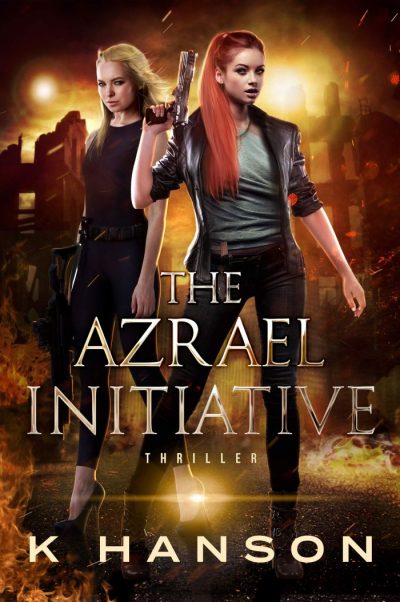 This feels less like a novel, than a novelization of a screenplay, adapted by a not particularly proficient writer. The text is littered with paragraphs which seem more like stage directions than literature, and is startlingly repetitive. For example, in one section near the beginning of the book, five of seven consecutive paragraphs start with, “As she/Kayla…” It’s not necessarily a bad screenplay, with an idea containing some potential. But it would be in need of several rewrites before any studio exec would sign off on it.
This feels less like a novel, than a novelization of a screenplay, adapted by a not particularly proficient writer. The text is littered with paragraphs which seem more like stage directions than literature, and is startlingly repetitive. For example, in one section near the beginning of the book, five of seven consecutive paragraphs start with, “As she/Kayla…” It’s not necessarily a bad screenplay, with an idea containing some potential. But it would be in need of several rewrites before any studio exec would sign off on it. Though it may be difficult to believe such a thing, the original Japanese title for this franchise of low-budget efforts was even more politically incorrect: Rape Zombie. If ever a title change was understandable… I went into this, largely on the basis of the covers, and braced for something awful. On that basis, I was pleasantly impressed: yes, this remains staggeringly offensive. Yet it’s clearly made by people who are familiar with, and love, zombie films. There are signs of actual brains being present – and not the kind normally found in the genre, being chewed on by the shambling antagonists. Five films have been made: for now, I’m covering the first three, which are the only ones available with subtitles [because, y’know, understanding the dialogue is
Though it may be difficult to believe such a thing, the original Japanese title for this franchise of low-budget efforts was even more politically incorrect: Rape Zombie. If ever a title change was understandable… I went into this, largely on the basis of the covers, and braced for something awful. On that basis, I was pleasantly impressed: yes, this remains staggeringly offensive. Yet it’s clearly made by people who are familiar with, and love, zombie films. There are signs of actual brains being present – and not the kind normally found in the genre, being chewed on by the shambling antagonists. Five films have been made: for now, I’m covering the first three, which are the only ones available with subtitles [because, y’know, understanding the dialogue is  There are four heroines in the series: two pairs, who team up following some initial distrust. Momoko (Kobayashi) ends up in hospital as the crisis breaks, after slashing her wrists at work. There, she’s befriended by nurse Nozomi (Ozawa), and when all hell breaks loose, the pair flee the hospital, and end up taking refuge in a Shinto shrine. There, they meet Kanae (Asami) and Tomoe (Aikawa), a battered housewife and a schoolgirl who have also been trying to survive the carnage. The actresses portraying all four, incidentally, are best known for their adult work, though seem to acquit themselves credibly enough with the (admittedly, fairly limited) acting required here.
There are four heroines in the series: two pairs, who team up following some initial distrust. Momoko (Kobayashi) ends up in hospital as the crisis breaks, after slashing her wrists at work. There, she’s befriended by nurse Nozomi (Ozawa), and when all hell breaks loose, the pair flee the hospital, and end up taking refuge in a Shinto shrine. There, they meet Kanae (Asami) and Tomoe (Aikawa), a battered housewife and a schoolgirl who have also been trying to survive the carnage. The actresses portraying all four, incidentally, are best known for their adult work, though seem to acquit themselves credibly enough with the (admittedly, fairly limited) acting required here. It would have been very easy for this to simply be a porn film with zombies in it, which I’m sure exist. As I hope the above makes clear, it isn’t. Horror fans will have fun spotting the riffs on other genre entries, such as the twist on Return of the Living Dead where a captive zombie is quizzed to its motivation: the answer here, naturally, being “More… pussy.” [As an aside, certain words are bleeped out on the Japanese soundtrack, which seems surprisingly prurient, given the nature of these films!] The second also introduces Shinji, a non-otaku seemingly unaffected by the epidemic, and his girlfriend, Maki; he becomes a key part of the scientific research, though it turns out his immunity isn’t quite what it seems. Despite the copious nudity, it all feels not dissimilar to George Romero’s Day of the Dead, located at the shadowy nexus of science and the military-industrial complex.
It would have been very easy for this to simply be a porn film with zombies in it, which I’m sure exist. As I hope the above makes clear, it isn’t. Horror fans will have fun spotting the riffs on other genre entries, such as the twist on Return of the Living Dead where a captive zombie is quizzed to its motivation: the answer here, naturally, being “More… pussy.” [As an aside, certain words are bleeped out on the Japanese soundtrack, which seems surprisingly prurient, given the nature of these films!] The second also introduces Shinji, a non-otaku seemingly unaffected by the epidemic, and his girlfriend, Maki; he becomes a key part of the scientific research, though it turns out his immunity isn’t quite what it seems. Despite the copious nudity, it all feels not dissimilar to George Romero’s Day of the Dead, located at the shadowy nexus of science and the military-industrial complex. This takes place in upstate New York during the 1812 war between Britain and America, when combatants are courting the Mohawk tribe to join forces with them. The natives are suspicious of both, and won’t commit to either. Working for the British is Joshua (Farren), who is in a slightly odd, three-way relationship with Mohawk warrioress Oak (Horn) and fellow native Calvin (Rain). On the other side is Hezekiah Holt (Buzzington), and his small band of Americans, who are out for redcoat blood. When they blame the Mohawk for murdering some of their number, their violence quickly extends to encompass Oak and Calvin, as well as Joshua. After Oak is left all alone, she goes on the war-path to take revenge on Holt and his men.
This takes place in upstate New York during the 1812 war between Britain and America, when combatants are courting the Mohawk tribe to join forces with them. The natives are suspicious of both, and won’t commit to either. Working for the British is Joshua (Farren), who is in a slightly odd, three-way relationship with Mohawk warrioress Oak (Horn) and fellow native Calvin (Rain). On the other side is Hezekiah Holt (Buzzington), and his small band of Americans, who are out for redcoat blood. When they blame the Mohawk for murdering some of their number, their violence quickly extends to encompass Oak and Calvin, as well as Joshua. After Oak is left all alone, she goes on the war-path to take revenge on Holt and his men. I was quite surprised to hear about Amazon taking up Joe Wright’s 2011
I was quite surprised to hear about Amazon taking up Joe Wright’s 2011